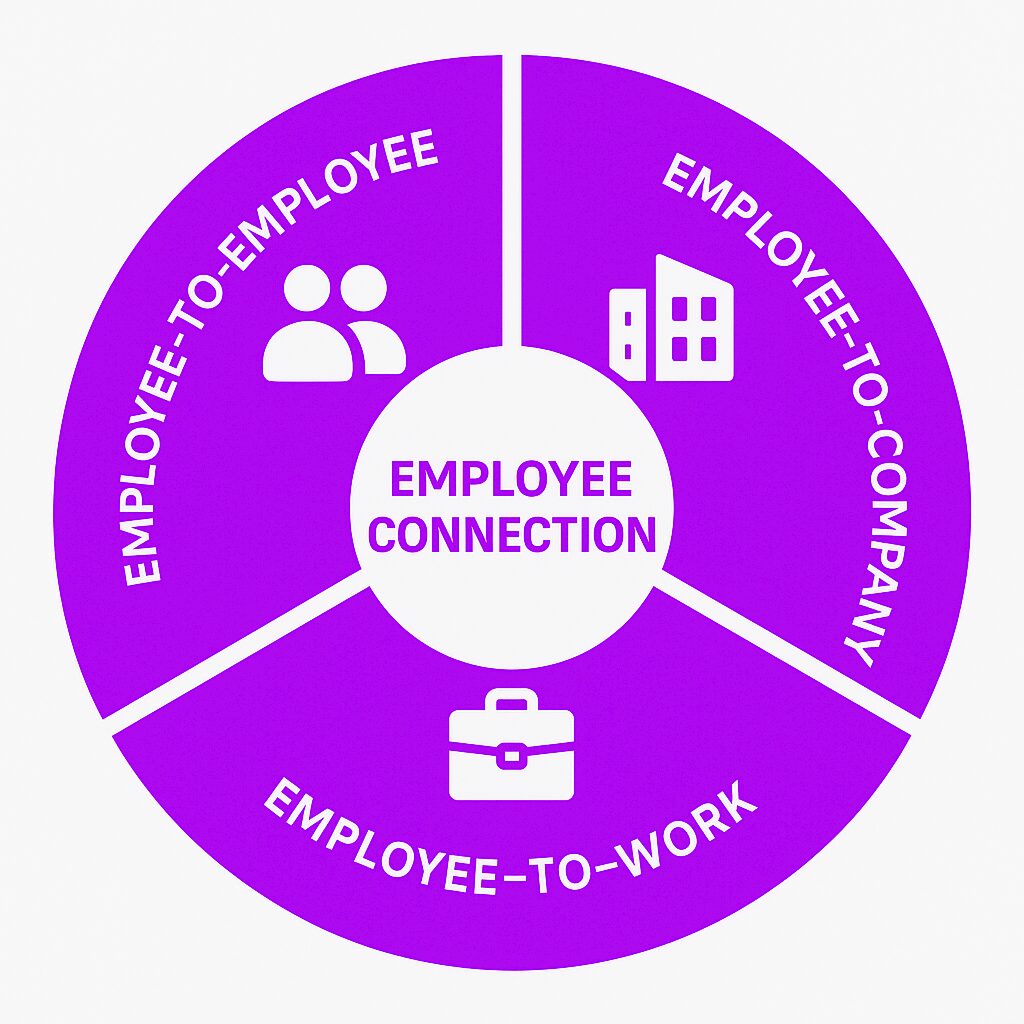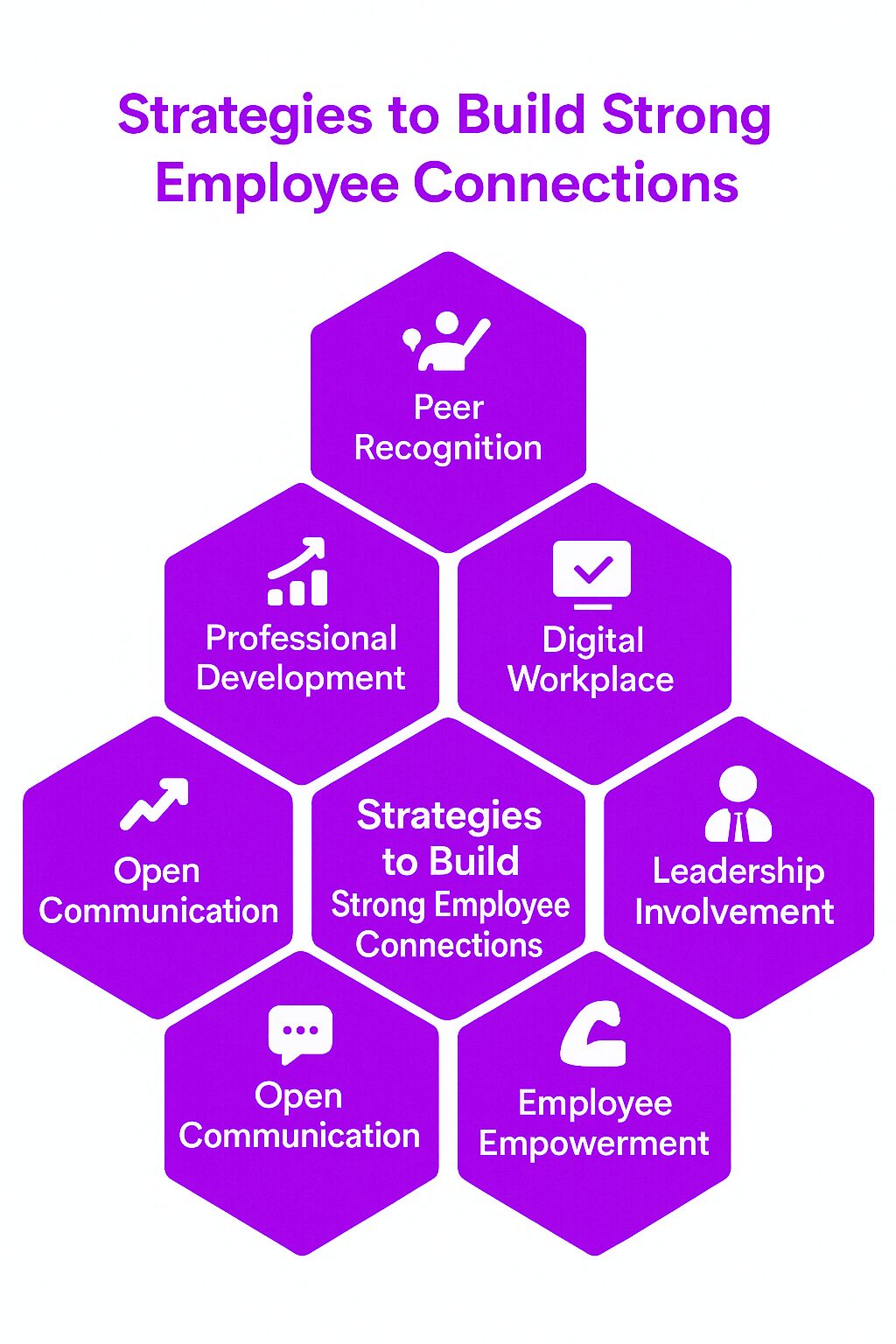What is Employee Connection?
Employee connection refers to the sense of belonging, engagement, and purpose employees feel within their organization. It goes beyond professional relationships—it encompasses alignment with company values, meaningful interactions with colleagues, and a sense of fulfillment in work. A strong employee connection fosters collaboration, enhances motivation, and strengthens workplace culture.
A workplace that prioritizes employee connection ensures that employees are not just physically present but emotionally and mentally invested in their roles. To achieve this, it is essential to build strong employee connections, which leads to better employee performance and retention. Employees who feel connected to their teams and the organization tend to be more engaged, productive, and committed.
The Key Components of Employee Connection
Employee-to-Employee Connection
The relationships employees form with their colleagues influence their overall work experience. Positive interactions with teammates create a supportive and collaborative environment. Effective internal communication channels not only keep employees informed and aligned towards shared goals but also contribute to a positive company culture, ultimately enhancing productivity and employee engagement.
Employee-to-Company Connection
Employees who align with the company’s mission and values feel more engaged. When they believe in the purpose of their work, they contribute with greater enthusiasm and commitment.
Employee-to-Work Connection
Feeling connected to one’s work means finding meaning and satisfaction in daily tasks. When employees see how their contributions impact the organization, they take ownership of their responsibilities.
Why Employee Connection Matters
Drives Employee Engagement and Motivation
Employee engagement is crucial for fostering a connected workforce. A connected employee is an engaged employee. When employees feel part of something bigger, they are more motivated to contribute meaningfully.
Enhances Collaboration and Teamwork
Workplaces that promote connection foster better teamwork. Employees communicate more effectively and work together to achieve common goals.
Boosts Productivity
Employees who feel supported by their peers and leadership tend to be more focused and efficient in their roles.
Reduces Turnover
Organizations with strong employee connections experience lower turnover rates. Employees are more likely to stay when they feel valued and appreciated.
Improves Employee Well-Being and Makes Employees Feel Valued
A connected workforce reports lower stress levels and higher job satisfaction. Social support in the workplace contributes to emotional resilience.
Strengthens Organizational Culture
A workplace built on connection fosters a culture of trust, respect, and shared purpose.
Fosters a Positive Work Environment
A positive work environment is the bedrock of strong employee connections and overall business success. When employees feel connected to their colleagues and the organization, they are more likely to be engaged, motivated, and productive. This environment is characterized by open and transparent communication, where employees feel heard and valued. Recognition plays a crucial role here; when employees’ efforts are acknowledged, it fosters a sense of appreciation and belonging.
Opportunities for growth and development further enhance this positive atmosphere. Employees who see a clear path for advancement within the organization are more likely to invest in their roles and build strong relationships with their peers. A positive work environment, therefore, is not just about physical space but about creating a culture where employees feel supported and valued. This culture of connection is essential for driving business success and ensuring that employees feel a genuine sense of belonging.
Challenges in Building Employee Connection
Remote Work and Virtual Barriers
Employees working remotely may struggle with isolation and disconnection from their teams.
Lack of Leadership Support
When leadership fails to prioritize employee connection, employees feel unimportant and disengaged.
Misalignment with Organizational Values
If employees do not resonate with the company’s mission, they may feel disconnected from their work.
Poor Communication Channels
Ineffective communication leads to misunderstandings, missed opportunities for collaboration, and decreased morale.
Strategies to Build Strong Employee Connections
Encourage Peer Recognition
Employees feel more connected when they receive appreciation from their peers. Recognition programs help build a culture of gratitude and support.
Organize Team-Building Activities
Regular team interactions, both virtual and in-person, foster camaraderie and trust.
Create a Centralized Digital Workplace
A well-structured intranet or collaboration tool ensures employees have easy access to information, updates, and discussions.
Offer Professional Development Opportunities
Employees who see a path for growth within the organization feel more invested in their work.
Foster Open and Transparent Communication
Providing spaces for employees to voice their ideas and concerns builds a sense of inclusion and belonging.
Encourage Leadership Involvement
When leaders actively engage with employees, they set the tone for a connected and engaged workforce.
Empower Employees
Empowering employees is a cornerstone of building strong employee connections and driving business success. When employees feel empowered, they are more likely to take ownership of their work, be motivated, and build meaningful connections with their colleagues. Empowerment involves giving employees the autonomy to make decisions, take risks, and learn from their mistakes. This sense of control over their work fosters a deeper connection to their roles and the organization.
Empowered employees feel valued and supported, which translates into stronger relationships with their peers and a greater sense of belonging. They are more likely to collaborate, innovate, and contribute to a positive workplace culture. By fostering an environment of employee empowerment, organizations can create a culture of connection that drives engagement, productivity, and long-term success.
Promote Cross-Functional Collaboration
Cross-functional collaboration is vital for building strong employee connections and driving business success. When employees from different departments and functions work together, they build relationships, share knowledge, and drive innovation. This collaboration breaks down silos and creates opportunities for employees to engage with colleagues outside their immediate teams.
By working on projects and initiatives with diverse groups, employees gain new perspectives and develop a deeper understanding of the organization as a whole. This not only enhances their sense of connection to the company but also fosters meaningful relationships with colleagues from various departments. Promoting cross-functional collaboration is essential for creating a culture of connection, where employees feel integrated and valued, ultimately driving business success.
Real-World Examples of Employee Connection
Tech Company Enhancing Digital Collaboration
A global tech firm introduced an internal social platform where employees could share insights, celebrate achievements, and collaborate on projects, resulting in improved engagement and teamwork.
Retail Chain Strengthening Recognition Programs
A leading retail company implemented a peer recognition program where employees could acknowledge each other’s efforts, leading to a stronger workplace culture.
Healthcare Provider Implementing Employee Feedback Channels
A healthcare organization created a platform where employees could share concerns and suggestions, improving transparency and engagement.
Final Thoughts
Employee connection is the foundation of a thriving workplace. Organizations that prioritize meaningful relationships, open communication, and shared purpose create an environment where employees feel valued and motivated. Investing in employee connection leads to better engagement, increased retention, and long-term business success.







